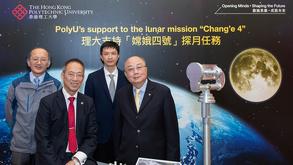HONG KONG - Scientists from Hong Kong universities and aspiring secondary students in the city were among those who have contributed to the nation’s decades-long exploration of space.
Here is a timeline of significant projects involving Hong Kong’s participation:
 The Camera Pointing System that Yung Kai-leung’s team designed for the Chang’e-4 lander was the first instrument designed and built in Hong Kong to be deployed for the nation’s lunar exploration program. (PHOTO PROVIDED TO CHINA DAILY)
The Camera Pointing System that Yung Kai-leung’s team designed for the Chang’e-4 lander was the first instrument designed and built in Hong Kong to be deployed for the nation’s lunar exploration program. (PHOTO PROVIDED TO CHINA DAILY)
2013
Chang’e 3 lunar probe mission
Hong Kong Polytechnic University
Designed the Camera Pointing System (CPS), which helps to photograph the moon and facilitates the mission control center in commanding the movement of the rover.
(The system was also used during the Chang’e 4 lunar probe mission in 2019.)
2015
The Chinese University of Hong Kong
Established the Joint Research Center for Health Maintenance of Musculoskeletal System on Space Medicine with the China Astronaut Research and Training Center.
 Five out of the six silkworms, chosen from more than 4,000 silkworms to be brought to the space lab, successfully made cocoons. (XINHUA)
Five out of the six silkworms, chosen from more than 4,000 silkworms to be brought to the space lab, successfully made cocoons. (XINHUA)
2016
Tiangong 2 space laboratory
Three Hong Kong secondary students
Designed three experiments that were conducted in the laboratory by astronauts. The experiments were devised to see whether silkworms can produce silk in space; how porous membranes are formed in space; and to examine chaos theory in space.
2017
Tianzhou 1 cargo spacecraft
Hong Kong Baptist University
Participated in research conducted in the spacecraft that investigated the effect of microgravity conditions on bone formation.
 This photo provided by the China National Space Administration (CNSA) shows Chang'e-5 probe gathering samples on the moon on Dec. 2, 2020. China's Chang'e-5 probe has completed sampling on the moon, and the samples have been sealed within the spacecraft, the CNSA announced Thursday morning. (CNSA/HANDOUT VIA XINHUA)
This photo provided by the China National Space Administration (CNSA) shows Chang'e-5 probe gathering samples on the moon on Dec. 2, 2020. China's Chang'e-5 probe has completed sampling on the moon, and the samples have been sealed within the spacecraft, the CNSA announced Thursday morning. (CNSA/HANDOUT VIA XINHUA)
2020
Chang’e 5 lunar probe mission
Hong Kong Polytechnic University
Designed the “Surface Sampling and Packing System”, which collects and packs samples from the lunar surface. The mission collected lunar samples of up to 2 kilograms and brought them back to Earth.
2020
The University of Hong Kong
Participated in the design of the satellite, which was tasked to complete several important space X-ray detection experiments.
2021
Tianwen-1 Mars probe mission
Hong Kong Polytechnic University
Helped identify landing regions on Mars with topographic mapping and geomorphological analysis technologies.
Manufactured a “Mars camera”, which was equipped on a lander to capture images of the red planet.


